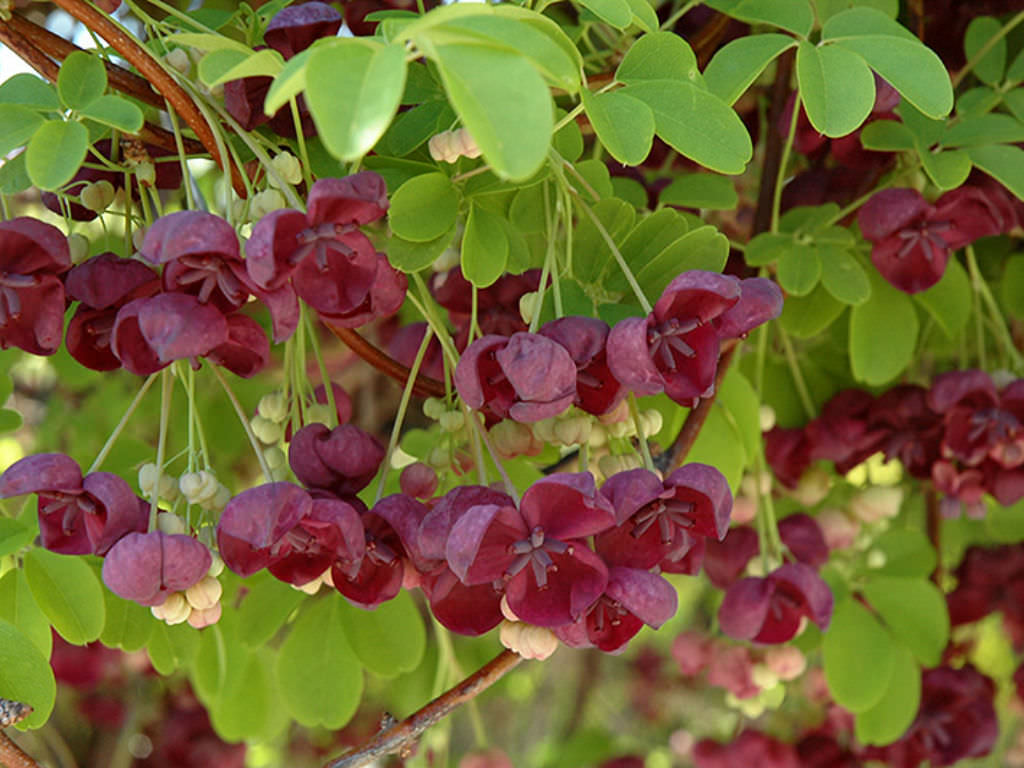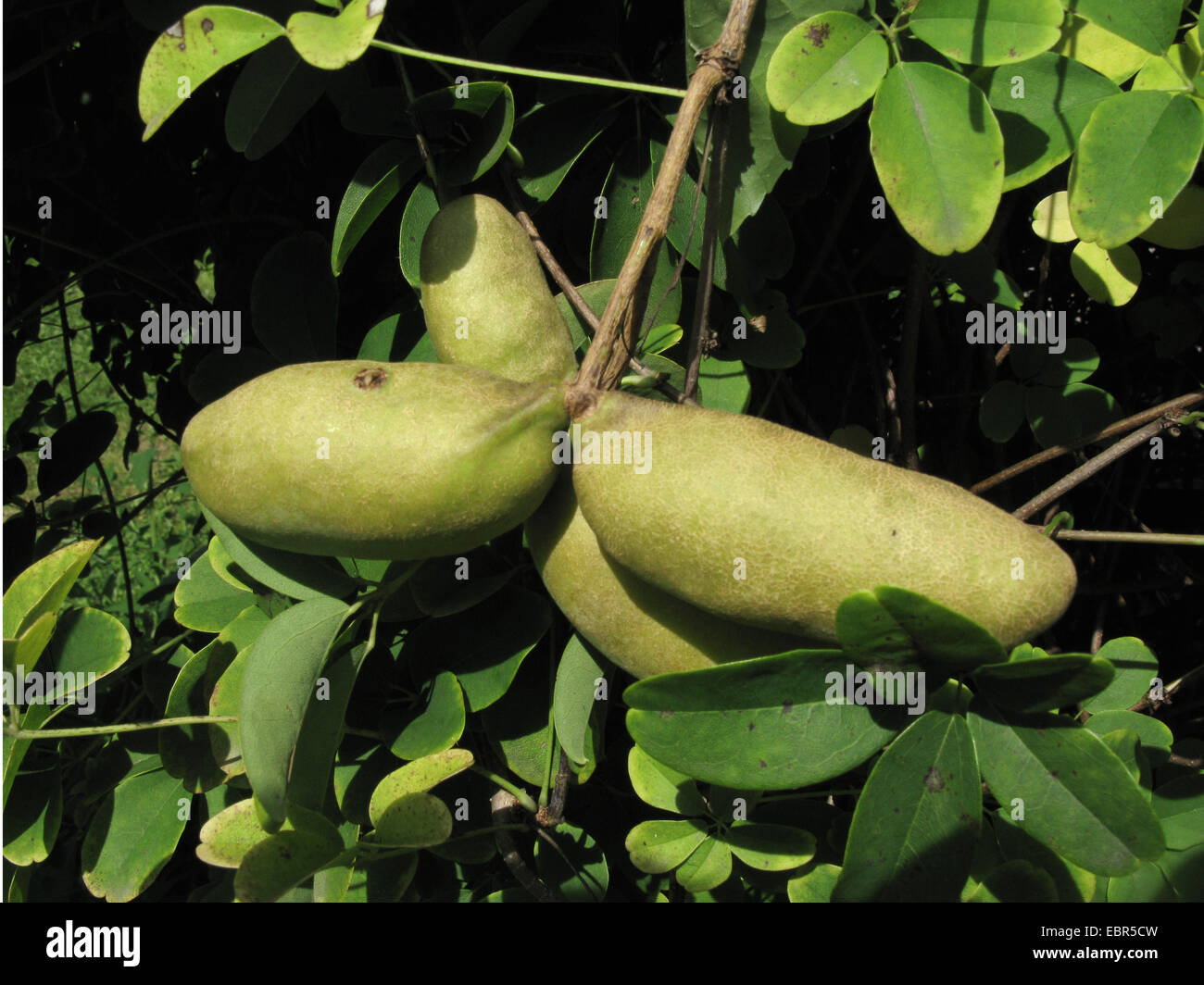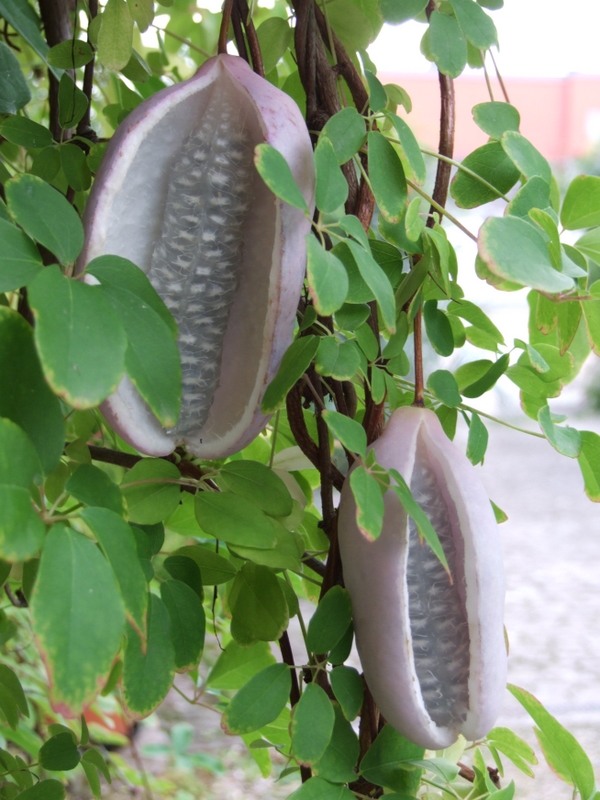
Chocolate vines Akebia trifoliata or Akebia quinata General Fruit Growing Growing Fruit
Akebia quinata produces glossy dark green oval-shaped leaves that grow in clusters of five. Plants have attractive blooms that carry a light chocolate scent. The aromatic flowers are replaced by four inch (10 cm) fruit pods containing small black seeds that drop in the autumn / fall. Chocolate Vine fruit, picture by gailhampshire; CC.
FileAkebia quinata fruits 0s1.JPG Wikimedia Commons
The fruit of Akebia quinata is a fleshy follicle, purple at maturity, straight or slightly incurved and oblong to ellipsoid in shape, and approximately 3-4 cm in diameter and 5-8 cm long (Figure 1d). Each fruit has over 100 brown to black shiny seeds with an ovoid, oblong shape, and edible white pulp.

Akebia quinata Big Plant Nursery
Akebia quinata is an unusual climber, best grown in warmer gardens since the flowers are prone to damage from late frosts. The maroon-chocolate flowers look almost artificial, with three thick, waxy 'petals' forming an inverted cup shape.. After a particularly warm summer, large sausage-shaped fruit dangle enticingly from the stems. Grow.
.jpg)
FileChocolate Vine, Akebia quinata fruit (36368946404).jpg Wikimedia Commons
Akebia quinata 'Alba': A varietal with pale green stems and small white flowers. In cooler climates, the leaves will turn bright yellow in the fall. Akebia quinata 'Purple Bouquet': This common varietal is desirable primarily because of its compact size, which will grow to be about half the height of other varieties. It boasts the same.

Akebia quinata (Chocolate Vine) World of Flowering Plants
The species A. quinata is known as chocolate vine or five-leaf akebia in Europe, America, and Japan, while it is usually called mutong or five-leaf akebia in China. Its flowers have a delicate, spicy chocolate fragrance that carries in the air. A. quinata plants are widely distributed in China, from an elevation of 300 m-1500 m, and are mainly distributed in southeast coastal provinces, such.

Akebia Quinata
Fruit is formed on the female flowers of the purple Akebia quinata. The white Akebia, however, is more likely to be sterile. So, if eating sugary-sweet, gelatinous fruit wrapped in a casing reminiscent of a hard sunglasses case isn't your thing, plant Akebia quinata 'Alba' instead of the purple.

Akebia Quinata Or Chocolate Vine Growing Tips
Akebia fruit growing in western Washington Ripe Akebia quinata grown in Washington state Akebia in North America. Akebia quinata is a minor invasive species in the majority of the East Coast and was introduced in 1845 as an ornamental plant. This is because the plant has no natural predators or diseases in North America and can grow as it pleases.

Akebia Quinata fruit. Had to pin this as I was so surprised to find that it bore fruit. Odd
The fruit is antirheumatic, depurative, diuretic, febrifuge, stomachic and tonic[218]. It is a popular remedy for cancer[218]. The root is febrifuge[218]. The plant was ranked 13th in a survey of 250 potential antifertility plants in China[218].. Akebia quinata is a reasonably hardy plant - when dormant, it can tolerate temperatures down to.

fiveleaf akebia, chocolate vine (Akebia quinata), fruit Stock Photo, Royalty Free Image
Fruit type (general) the fruit is dry and splits open when ripe Bark texture. the bark of an adult plant is ridged or plated; the bark of an adult plant is thin and smooth. Akebia quinata, on the other hand, has leaves with (3-) 5 (-7) leaflets that have entire to undulate margins (rarely with 1 or 2 obscure teeth).
.jpg)
FileAkebia quinata (fruits 2p).jpg Wikimedia Commons
This datasheet on Akebia quinata covers Identity, Overview, Distribution, Dispersal, Diagnosis, Biology & Ecology, Environmental Requirements, Natural Enemies, Impacts, Uses, Prevention/Control, Management, Genetics and Breeding, Further Information.. Heavy harvest of Akebia species fruit for medicinal purposes in the wild has resulted in a.

Amazing Akebia Fruit. And Bradenton exotic Fruitpark YouTube
Vigorously spreading, Akebia quinata (Chocolate Vine) is a dainty semi-evergreen, twining, woody vine with dangling racemes of small, wine-red flowers with a spicy, chocolate fragrance in spring. The blooms stand out against the bright green foliage of elliptic leaflets which becomes purple flushed in cold weather. If the summer is long and warm, the flowers will give way to a crop of unusual.

Akebia Quinata (klimbes) Klimplant van de maand april Blog
Two different varieties must be planted closely together in order to produce fruit. All Akebia vines are fast-growing to around 25-30', grow in sun or shade, and are hardy to Zone 5-6. Varieties: Akebia quinata - Five-leaf Akebia. Dusky purple flowers and blue-green leaves with purple new growth. Leaves are on the smaller side, about 2-3.

AKEBI FRUIT Akebia Quinata (aka Chocolate Vine or FiveLeaf Akebia) is a shrub that is native
Chocolate vine (Akebia quinata), also known as five leaf akebia, is a highly fragrant, vanilla scented vine that is hardy in USDA zones 4 through 9. This deciduous semi-evergreen plant reaches its mature height of 15 to 20 feet (4.5-6 m.) rapidly and produces beautiful lilac flowers from May through June.. If you wish to have fruit, you must.

The Garden Diaries Akebia Quinata
Give akebia a sturdy support—it grows large and heavy at maturity and may crush small structures. If springtime flowers are pollinated, akebia may produce edible, sausage-shape fruits. The vine usually needs a different variety planted nearby to produce fruit. Though edible, the fruit is not particularly tasty.
.jpg)
FileAkebia quinata (fruits s16).jpg Wikimedia Commons
Akebia quinata, commonly known as chocolate vine,. A bunch of Akebia fruit growing on a vine in western Washington) Akebia prefers sandy soils with good drainage, and regular watering, though it is drought resistant. In some areas the plant is an invasive species to be avoided.

DateiAkebia quinata fruit.jpg mediterraner Garten in Schwebsingen
Akebia Species: quinata Family: Lardizabalaceae Uses (Ethnobotany): The vines are used for basketweaving. Life Cycle: Woody Country Or Region Of Origin: China, Korea, and Japan Wildlife Value: Birds eat the fruits and disperse the seeds. Play Value: Attractive Flowers Edible fruit Fragrance Wildlife Food Source